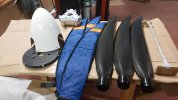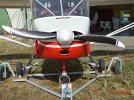meglin
Pre-takeoff checklist
Dear friends and colleagues!
Due to the fact that quite a lot of our propellers are in operation in your country, I will allow myself to remind about one important rule.
I do not know how much it is accepted in your country. In our country it is accepted automatically and without reminding. This rule is related to the storage of aircraft in the open air.
So: after every precipitation any covers must be removed and dried. At the same time, the aircraft unit itself is ventilated and dried. If it is necessary to speed up drying, it is desirable to turn the covers out.
This applies to any airplane unit as well as to the propeller. It turns out that many operators do not do this. It rains, and the equipment literally sours in water for many days. At the same time, the safety of the equipment under the covers does not improve, but significantly worsens! Ventilation is impeded and corrosion develops.
Covers are designed to protect against UV light, accidental scratches, dust and dirt, from direct water ingress. But after rain, they aggravate the situation by making ventilation more difficult.
In the case of a propeller, the lower blades literally float in water after a heavy rain. The dense outer fabric prevents the water from evaporating quickly. The soft inner fabric is excellent at absorbing moisture and retaining it for a long time.
We know that rainwater contains impurities and is an electrolyte. The epoxy surface layer, while chemically resistant, can gradually discolor and cause unnecessary issues. We have supplied thousands of propellers but have already had two similar recalls. That is why I took the liberty of reminding myself of this rule.
Please pardon my English.
Due to the fact that quite a lot of our propellers are in operation in your country, I will allow myself to remind about one important rule.
I do not know how much it is accepted in your country. In our country it is accepted automatically and without reminding. This rule is related to the storage of aircraft in the open air.
So: after every precipitation any covers must be removed and dried. At the same time, the aircraft unit itself is ventilated and dried. If it is necessary to speed up drying, it is desirable to turn the covers out.
This applies to any airplane unit as well as to the propeller. It turns out that many operators do not do this. It rains, and the equipment literally sours in water for many days. At the same time, the safety of the equipment under the covers does not improve, but significantly worsens! Ventilation is impeded and corrosion develops.
Covers are designed to protect against UV light, accidental scratches, dust and dirt, from direct water ingress. But after rain, they aggravate the situation by making ventilation more difficult.
In the case of a propeller, the lower blades literally float in water after a heavy rain. The dense outer fabric prevents the water from evaporating quickly. The soft inner fabric is excellent at absorbing moisture and retaining it for a long time.
We know that rainwater contains impurities and is an electrolyte. The epoxy surface layer, while chemically resistant, can gradually discolor and cause unnecessary issues. We have supplied thousands of propellers but have already had two similar recalls. That is why I took the liberty of reminding myself of this rule.
Please pardon my English.




